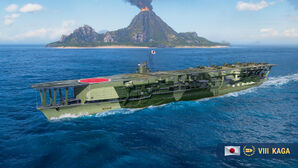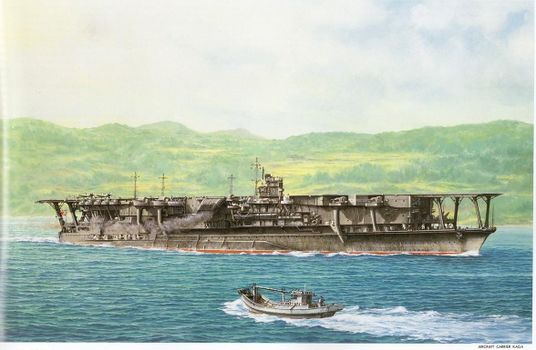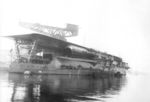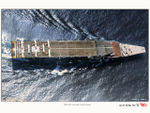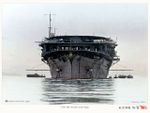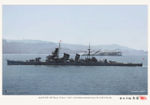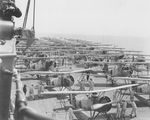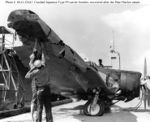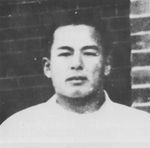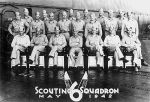Kaga
| Revision as of 19:05, 26 March 2018 | Revision as of 14:49, 11 May 2018 Minor polish. | |||
| Line 11: | Line 11: | |||
| ''Kaga'' features a powerful flight module with two potential loadouts. Her default setup allows her to punish anything that has inadequate AA, or has had its AA reduced over the course of the battle. Featuring two fighter squadrons, two torpedo bomber squadrons, and one dive bomber squadron, this configuration provides potentially devastating offensive power; her six-plane torpedo squadrons can push home a punishing strike while her fighters tie up the fighter squadron(s) of the enemy carrier(s). Her second flight module is less attractive, dropping one fighter squadron and one torpedo squadron in favor of two additional dive bomber squadrons. While the drop reticle for her dive bombers is small and getting all bombs to hit enemy capital ships is not difficult, the bombs themselves are very anemic, doing minimal damage and with the lowest fire chance of all carrier-dropped bombs in the game. Her primary flight module is radically more effective at doing what ''Kaga'' does best: wrecking enemy surface ships with torpedo strikes. | ''Kaga'' features a powerful flight module with two potential loadouts. Her default setup allows her to punish anything that has inadequate AA, or has had its AA reduced over the course of the battle. Featuring two fighter squadrons, two torpedo bomber squadrons, and one dive bomber squadron, this configuration provides potentially devastating offensive power; her six-plane torpedo squadrons can push home a punishing strike while her fighters tie up the fighter squadron(s) of the enemy carrier(s). Her second flight module is less attractive, dropping one fighter squadron and one torpedo squadron in favor of two additional dive bomber squadrons. While the drop reticle for her dive bombers is small and getting all bombs to hit enemy capital ships is not difficult, the bombs themselves are very anemic, doing minimal damage and with the lowest fire chance of all carrier-dropped bombs in the game. Her primary flight module is radically more effective at doing what ''Kaga'' does best: wrecking enemy surface ships with torpedo strikes. | |||
| ? | Like '[[Hiryu]]'' — her contemporary in the Japanese tech tree — ''Kaga''’s fighters are capable of holding their own if her captain invests in the Dogfighting Expert commander skill and mounts all available fighter-enhancing upgrades. ''Kaga'' also has 203mm secondary guns, but as they are secondaries, they are short range and relatively inaccurate, making them more for entertainment value than actual combat. | + | Like ''[[Hiryu]]'' — her contemporary in the Japanese tech tree — ''Kaga''’s fighters are capable of holding their own if her captain invests in the Dogfighting Expert commander skill and mounts all available fighter-enhancing upgrades. ''Kaga'' also has 203mm secondary guns, but as they are secondaries, they are short range and relatively inaccurate, making them more for entertainment value than actual combat. | |
| Captains who purchase relevant fighter and torpedo bomber upgrades and skills while focusing their energy on pushing home torpedo strikes against enemy targets will be happy with their investment in ''Kaga''. | Captains who purchase relevant fighter and torpedo bomber upgrades and skills while focusing their energy on pushing home torpedo strikes against enemy targets will be happy with their investment in ''Kaga''. | |||
| Line 35: | Line 35: | |||
| |Research=<!-- write text about priority sequence of research below --> | |Research=<!-- write text about priority sequence of research below --> | |||
| ? | As a | + | As a Premium ship, ''Kaga'' doesn't have any upgrades to research. | |
| |OptimalConfiguration=<!-- write some general text about selection of optimal configuration below (optional)--> | |OptimalConfiguration=<!-- write some general text about selection of optimal configuration below (optional)--> | |||
| Line 47: | Line 47: | |||
| '''Upgrade Slot 3''' is the main choice of upgrades with ''{{#var:ship_name}}''. For players looking to improve their fighter's capabilities, {{Air Groups Modification 2}} is highly recommended, especially when using the Type 7 mod. 2 flight control system. Otherwise, the {{Flight Control Modification 1}} helps players land and launch ''{{#var:ship_name}}''`s multiple flight squadrons. | '''Upgrade Slot 3''' is the main choice of upgrades with ''{{#var:ship_name}}''. For players looking to improve their fighter's capabilities, {{Air Groups Modification 2}} is highly recommended, especially when using the Type 7 mod. 2 flight control system. Otherwise, the {{Flight Control Modification 1}} helps players land and launch ''{{#var:ship_name}}''`s multiple flight squadrons. | |||
| ? | ||||
| |CommanderSkills=<!-- write text about best set of Commander Skills below --> | |CommanderSkills=<!-- write text about best set of Commander Skills below --> | |||
| Line 90: | Line 89: | |||
| |Consumables=<!-- write text about selection of Consumables below --> | |Consumables=<!-- write text about selection of Consumables below --> | |||
| ? | + | ''{{#var:ship_name}}'' can equip the following consumables: | ||
| + | * '''Slot 1:''' {{Damage Control Party}} | |||
| + | ||||
| + | Due to ''Kaga''’s poor concealment, the premium version of this consumable is recommended in case enemy surface ships decide to focus fire on her with high explosive rounds. | |||
| |Camouflage=<!-- write text about useful camouflage below --> | |Camouflage=<!-- write text about useful camouflage below --> | |||
| ? | As a | + | As a Premium ship, ''Kaga'' comes included with [[Ship:Camouflage#Premium_Camouflage|Type 10 camouflage]] that lowers her detection radius, reduces the accuracy of incoming shells, and increases the amount of experience she earns. | |
| |Signals=<!-- write text about best set of signals below --> | |Signals=<!-- write text about best set of signals below --> | |||
| Line 189: | Line 191: | |||
| }} | }} | |||
| </div> | </div> | |||
| + | [[File:Kaga.jpeg|none|frame|x350px|link=|Artist's rendering of ''Kaga''.]] | |||
| ? | ||||
| ===Design=== | ===Design=== | |||
| ''Kaga'' was originally conceived as a ''Tosa''-class battleship, the would-be successors to the ''[[Nagato]]''-class of battleships. The fate of the ''Tosa''-class ships was irrevocably altered in 1922 as a result of the Washington Naval Treaty; all major naval powers agreed to adhere to a moratorium on battleship construction. ''Kaga''’s fate was sealed: she would be scrapped. In the treaty’s wake, the Japanese sought to convert two of their incomplete ''[[Amagi]]''-class battlecruisers – ''Amagi'' and ''Akagi'' – into aircraft carriers as the treaty allowed two capital ship hulls above 30,000 tons to undergo conversion. In a twist of fate, ''Amagi'' was damaged during the 1923 Tokyo earthquake and ''Kaga'' received a new lease on life; substituted in the former’s place for conversion work. | ''Kaga'' was originally conceived as a ''Tosa''-class battleship, the would-be successors to the ''[[Nagato]]''-class of battleships. The fate of the ''Tosa''-class ships was irrevocably altered in 1922 as a result of the Washington Naval Treaty; all major naval powers agreed to adhere to a moratorium on battleship construction. ''Kaga''’s fate was sealed: she would be scrapped. In the treaty’s wake, the Japanese sought to convert two of their incomplete ''[[Amagi]]''-class battlecruisers – ''Amagi'' and ''Akagi'' – into aircraft carriers as the treaty allowed two capital ship hulls above 30,000 tons to undergo conversion. In a twist of fate, ''Amagi'' was damaged during the 1923 Tokyo earthquake and ''Kaga'' received a new lease on life; substituted in the former’s place for conversion work. | |||
| Line 202: | Line 204: | |||
| ''Kaga'' ’s battleship pedigree was seen through her retention of a main armaments battery. In her original configuration she possessed ten 20cm Type 3 rifles: four in twin-gun turrets flanking the middle flight deck forward, and six in single casemate mounts aft. The Type B turret mounts were unique to ''Kaga'' and ''Akagi'' that they could elevate to +70˚ to combat aircraft, in theory. The casemates themselves saw limited practicality as they had limited elevation and traverse. Such firepower was added in the belief that carriers should have the autonomous ability to repel surface threats. Additionally, she was armed with twelve 120mm Type 10 guns in six twin-mounts in sponsons off the side. They were hampered by restricted firing angles due to their position. | ''Kaga'' ’s battleship pedigree was seen through her retention of a main armaments battery. In her original configuration she possessed ten 20cm Type 3 rifles: four in twin-gun turrets flanking the middle flight deck forward, and six in single casemate mounts aft. The Type B turret mounts were unique to ''Kaga'' and ''Akagi'' that they could elevate to +70˚ to combat aircraft, in theory. The casemates themselves saw limited practicality as they had limited elevation and traverse. Such firepower was added in the belief that carriers should have the autonomous ability to repel surface threats. Additionally, she was armed with twelve 120mm Type 10 guns in six twin-mounts in sponsons off the side. They were hampered by restricted firing angles due to their position. | |||
| ? | In 1934, ''Kaga'' underwent a massive reconstruction in the hopes to solve many of her glaring deficiencies. The impractical multi flight-deck configuration was removed and instead the top flight deck was rebuilt to span the entire length of the ship. Concurrently, the hangers were extended and she received a third elevator situated to the front. As well, an island superstructure was added to the starboard side of the flight deck. In hopes to increase speed, 4 multi-staged turbines and 8 oil-fired boilers replaced her original 4 single-stage turbines and 12 mixed-fuel boilers; this increased power by over 30,000 shaft horsepower. But due to the addition of extra torpedo bulges to lower her | + | In 1934, ''Kaga'' underwent a massive reconstruction in the hopes to solve many of her glaring deficiencies. The impractical multi flight-deck configuration was removed and instead the top flight deck was rebuilt to span the entire length of the ship. Concurrently, the hangers were extended and she received a third elevator situated to the front. As well, an island superstructure was added to the starboard side of the flight deck. In hopes to increase speed, 4 multi-staged turbines and 8 oil-fired boilers replaced her original 4 single-stage turbines and 12 mixed-fuel boilers; this increased power by over 30,000 shaft horsepower. But due to the addition of extra torpedo bulges to lower her center-of-gravity, her displacement increased as well and thus she only gained a single knot of speed. ''Kaga'' ’s original rearward exhaust system was changed to a single down-turned funnel off the starboard side. With the removal of the middle fight-deck, the 20cm guns in the front were also moved to the aft as 4 additional casemates. The 120mm AA guns were replaced with sixteen 127mm Type 89 guns in 8 twin-mounts and additionally twenty-two 25mm Type 96 AA guns in 11 twin-mounts were added. The Type 89 had good performance, but their real deficiency was seen in their mounts and fire control directors. Both were manually operated and in the heat of combat, could not track fast moving targets. The Type 96 had poor performance. Not only were the weapons manually trained, but also the hitting power was under-average, and the usage of 15-round magazines severely hampered sustained rate-of-fire. | |
| ? | In retrospect, one of ''Kaga'' ’s more significant drawbacks that were never addressed was the design of her aircraft hangars. Most Japanese fleet carriers were constructed with enclosed, | + | In retrospect, one of ''Kaga'' ’s more significant drawbacks that were never addressed was the design of her aircraft hangars. Most Japanese fleet carriers were constructed with enclosed, unarmored hangars, with a significant thinness on the sides. This was in hopes that an explosion would be vent laterally instead of vertically; saving the flight deck. In actuality, the opposite occurred; damage to the hangar deck ruptured the flight deck. Considering aircraft refueling and rearming occurred in the hangars, poor ventilation and fire suppression systems meant damage to the hangars were difficult to mitigate and were crippling to the ship. | |
| ''Kaga'' was built at the Kawasaki Heavy Industries shipyard in Kobe, Japan. After her official reclassification in 1923, work on her conversion commenced at the Yokosuka Naval Arsenal in 1925, and completed by 1928. A year later, she was commissioned into the Imperial Japanese Navy as their latest fleet carrier. | ''Kaga'' was built at the Kawasaki Heavy Industries shipyard in Kobe, Japan. After her official reclassification in 1923, work on her conversion commenced at the Yokosuka Naval Arsenal in 1925, and completed by 1928. A year later, she was commissioned into the Imperial Japanese Navy as their latest fleet carrier. | |||
| ===Service=== | ===Service=== | |||
| ? | Four years after her completion and commission, ''Kaga''’s first combat action came in early 1932 where ''Kaga'', flagship of the 1st Carrier Division alongside ''[[Hosho]]'', spent the entirety of February supporting the Imperial Japanese Army’s attack on the Chinese coastal lynchpin of Shanghai. During these engagements, three of ''Kaga''’s Nakajima A1N2 fighters scored the IJN’s first air-to-air combat victory in late February against the Chinese forces. Following the ceasefire on the 3rd of March, ''Kaga'' and ''[[Hosho]]'' returned to the Combined Fleet to resume training exercises. These early carrier exercises were vital to the development of both Japanese and international carrier doctrines. Aircraft carriers were initially intended to act as force multipliers in the Imperial Japanese Navy, primarily by supporting the fleet’s Battleships as per the “decisive battle” doctrine. As carrier doctrine evolved, aerial strikes against enemy carriers became of equal importance to battleship engagements, to secure air superiority during a battle to allow carriers to attack enemy surface vessels with little to no danger from enemy fighters. Aircraft carriers would operate with or ahead of the main | + | Four years after her completion and commission, ''Kaga''’s first combat action came in early 1932 where ''Kaga'', flagship of the 1st Carrier Division alongside ''[[Hosho]]'', spent the entirety of February supporting the Imperial Japanese Army’s attack on the Chinese coastal lynchpin of Shanghai. During these engagements, three of ''Kaga''’s Nakajima A1N2 fighters scored the IJN’s first air-to-air combat victory in late February against the Chinese forces. Following the ceasefire on the 3rd of March, ''Kaga'' and ''[[Hosho]]'' returned to the Combined Fleet to resume training exercises. These early carrier exercises were vital to the development of both Japanese and international carrier doctrines. Aircraft carriers were initially intended to act as force multipliers in the Imperial Japanese Navy, primarily by supporting the fleet’s Battleships as per the “decisive battle” doctrine. As carrier doctrine evolved, aerial strikes against enemy carriers became of equal importance to battleship engagements, to secure air superiority during a battle to allow carriers to attack enemy surface vessels with little to no danger from enemy fighters. Aircraft carriers would operate with or ahead of the main battle line, and an emphasis on high top speed and larger aircraft requiring longer flightdecks. Due to this shift in ideology, ''Kaga'' was judged inferior to her half-sister ''Akagi'' due to her lower top speed and smaller flight deck, on top of her problematic funnel arrangement, and was first in line for an extensive reconstruction that lasted from 1934 until the middle of 1935. | |
| ? | Following the completion of her reconstruction, ''Kaga'' was assigned to Carrier Division 2 as the only carrier of the division, where she trained for another two years until the Marco Polo Bridge incident that sparked the full-on war between Japan and the Chinese coalition that was the Second Sino-Japanese War. In 1937, ''Kaga'' joined CarDiv 1 alongside ''[[Ryujo]]'' and ''[[Hosho]]'' to attack central and southern China with the IJN, while the IJA pushed down from the north. ''Kaga''’s air group engaged the Chinese | + | Following the completion of her reconstruction, ''Kaga'' was assigned to Carrier Division 2 as the only carrier of the division, where she trained for another two years until the Marco Polo Bridge incident that sparked the full-on war between Japan and the Chinese coalition that was the Second Sino-Japanese War. In 1937, ''Kaga'' joined CarDiv 1 alongside ''[[Ryujo]]'' and ''[[Hosho]]'' to attack central and southern China with the IJN, while the IJA pushed down from the north. ''Kaga''’s air group engaged the Chinese air force over central China, with mixed successes. An attack group consisting of 29 attack planes and 16 bombers with no fighter escort took off to strike multiple targets on the Chinese coastline. They were forced to change targets due to bad weather, and were then intercepted by Chinese fighters, losing eight attack planes and surrendering a ninth. Exact total losses are unclear, but it was enough to forbid any aerial bombing mission without fighter escorts. Japanese fighters, however, often had great success against the exported American fighters the Chinese Airforce used, suffering little to no losses in dogfights while escorting Japanese attack aircraft. ''Kaga''’s final attack during this sortie was several strikes against the Chinese light cruisers ''Ping Hai'' and ''Ning Hai''. Both ships sunk in the banks of the Yangtze River, to later be risen and put into service by the IJN. ''Kaga'' and CarDiv 1 spent the rest of 1937 moving to and from mainland Japan and occupied China, ferrying aircraft for land bases or carrying out strikes herself. In December 1937, a group of IJN aircraft launched from ''Kaga'' attacked three oil barges escorted by the American river gunboat USS ''Panay'' (PR-5), sinking the three barges and USS ''Panay'', taking American lives with it. This resulted in “The Panay Incident”, which while Japan apologized to the USA and paid an indemnity, but this nonetheless turned US opinion against Japan. | |
| ''Kaga'' continued supporting Japanese attacks on central China until the end of 1938, where she returned to Japan and was placed in reserve status to undergo a second lengthy overhaul, lasting until late 1940. ''Kaga''’s experiences off China further solidified the advanced IJN carrier doctrine, emphasizing on the importance in amassing and concentrating naval air power offshore for successful land attacks. In April 1941, the IJN formed the First Air Fleet that placed all its fleet carriers under a single command. ''Kaga'' joined the First Carrier Division alongside her half-sister ''Akagi'', spending most of 1941 training with their new-age aircraft in preparation for the Attack on Pearl Harbor. With training complete by November that year, ''Kaga'' moved to the Kurils to prepare for the secret Hawaii Operation, where the IJN amassed their naval power. By December 6th, 1941, ''Kaga'' and the Combined Fleet of the IJN were 400 miles north of Hawaii, where the fleet oilers present detached with a destroyer escort before the carriers continued into Hawaiian waters to enter striking range. | ''Kaga'' continued supporting Japanese attacks on central China until the end of 1938, where she returned to Japan and was placed in reserve status to undergo a second lengthy overhaul, lasting until late 1940. ''Kaga''’s experiences off China further solidified the advanced IJN carrier doctrine, emphasizing on the importance in amassing and concentrating naval air power offshore for successful land attacks. In April 1941, the IJN formed the First Air Fleet that placed all its fleet carriers under a single command. ''Kaga'' joined the First Carrier Division alongside her half-sister ''Akagi'', spending most of 1941 training with their new-age aircraft in preparation for the Attack on Pearl Harbor. With training complete by November that year, ''Kaga'' moved to the Kurils to prepare for the secret Hawaii Operation, where the IJN amassed their naval power. By December 6th, 1941, ''Kaga'' and the Combined Fleet of the IJN were 400 miles north of Hawaii, where the fleet oilers present detached with a destroyer escort before the carriers continued into Hawaiian waters to enter striking range. | |||
Revision as of 14:49, 11 May 2018
| 127 mm/40 Type 89 on a Model A1 mount6 х 2 pcs. |
| Firing Range4.5 km. |
| Rate of Fire12 shots/min. |
| Reload Time5 sec. |
| HE Shell127 mm HE Type0 |
| Maximum HE Shell Damage2,100 |
| Initial HE Shell Velocity725 m./s. |
| Chance of Fire on Target Caused by HE Shell8 % |
| 200 mm/50 3rd Year Type No.1 in a Model A turret10 х 1 pcs. |
| Firing Range4.5 km. |
| Rate of Fire4 shots/min. |
| Reload Time15 sec. |
| HE Shell200 mm Common Type4 HE |
| Maximum HE Shell Damage3,300 |
| Initial HE Shell Velocity870 m./s. |
| Chance of Fire on Target Caused by HE Shell17 % |
| 127 mm/40 Type 89 on a Model A1 Mod.3 mount2 х 2 pcs. |
| Firing Range4.5 km. |
| Rate of Fire10 shots/min. |
| Reload Time6 sec. |
| HE Shell127 mm HE Type0 |
| Maximum HE Shell Damage2,100 |
| Initial HE Shell Velocity725 m./s. |
| Chance of Fire on Target Caused by HE Shell8 % |
| 127 mm/40 Type 89 on a Model A1 mount6 х 2 pcs. |
| . . . Average Damage per Second60.6 |
| . . . Firing Range5.01 km. |
| 127 mm/40 Type 89 on a Model A1 Mod.3 mount2 х 2 pcs. |
| . . . Average Damage per Second20.2 |
| . . . Firing Range5.01 km. |
| 25 mm/60 Type 96 on a twin mount14 х 2 pcs. |
| . . . Average Damage per Second37.8 |
| . . . Firing Range2.49 km. |
| Maximum Speed28 knot |
| Turning Circle Radius1 080 m. |
| Rudder Shift Time14.4 sec. |
| Surface Detectability Range12.22 km. |
| Air Detectability Range10.9 km. |
Kaga — Japanese special premium Tier VIII aircraft сarrier.
Until the early 1940s, she was one of the biggest aircraft carriers of the Imperial Japanese Navy. Initially laid down as a battleship, she was redesigned during construction to become a carrier. The ship had good armor protection for her type, carried quite numerous air group and powerful secondary battery guns.
Kaga first went on sale on 5 June 2017 on the NA servers, and on 2 June 2017 on the EU servers.
Modules
 |
Speed (knot) | IDS_SHIP_PARAM_SQUADRON_MED_DAMAGE (HP/min) | IDS_SHIP_PARAM_SQUADRON_AMMO_AMOUNT | Hit Points (HP) |
Research price (exp) |
Purchase price ( | |
|---|---|---|---|---|---|---|---|
| A6M5 Zero | 144 | 1,330 | 0 | 0 |
 |
Maximum Torpedo Damage (HP) | Speed (knot) | Hit Points (HP) |
Research price (exp) |
Purchase price ( | |
|---|---|---|---|---|---|---|
| B6N Tenzan | 5,400 | 133 | 1,600 | 0 | 0 |
Compatible Upgrades
| Slot 1 |
|||||
|---|---|---|---|---|---|
| Slot 2 |
|||||
| Slot 3 |
|||||
| Slot 4 |
|||||
| Slot 5 |
Player Opinion
Performance
Kaga is a Tier VII premium Japanese aircraft carrier. Unlike Saipan’s style of having fewer, higher tier aircraft, Kaga instead provided her captain with large numbers of lower tier aircraft. She is able to launch copious amounts of bombers at the enemy team, but must be careful of the anti-aircraft abilities of same and higher-tier ships. Her planes are also slower than other carriers at her tier, meaning they are unable to outrun enemy aircraft and will spend more time under fire by enemy anti-aircraft batteries.
Kaga features a powerful flight module with two potential loadouts. Her default setup allows her to punish anything that has inadequate AA, or has had its AA reduced over the course of the battle. Featuring two fighter squadrons, two torpedo bomber squadrons, and one dive bomber squadron, this configuration provides potentially devastating offensive power; her six-plane torpedo squadrons can push home a punishing strike while her fighters tie up the fighter squadron(s) of the enemy carrier(s). Her second flight module is less attractive, dropping one fighter squadron and one torpedo squadron in favor of two additional dive bomber squadrons. While the drop reticle for her dive bombers is small and getting all bombs to hit enemy capital ships is not difficult, the bombs themselves are very anemic, doing minimal damage and with the lowest fire chance of all carrier-dropped bombs in the game. Her primary flight module is radically more effective at doing what Kaga does best: wrecking enemy surface ships with torpedo strikes.
Like Hiryu — her contemporary in the Japanese tech tree — Kaga’s fighters are capable of holding their own if her captain invests in the Dogfighting Expert commander skill and mounts all available fighter-enhancing upgrades. Kaga also has 203mm secondary guns, but as they are secondaries, they are short range and relatively inaccurate, making them more for entertainment value than actual combat.
Captains who purchase relevant fighter and torpedo bomber upgrades and skills while focusing their energy on pushing home torpedo strikes against enemy targets will be happy with their investment in Kaga.
Pros:
- Has the largest hangar size of any Tier VII aircraft carrier at 85 planes.
- Kaga carries a powerful secondary armament consisting of several 127mm and 203mm guns.
- Has the largest number of hit points of any carrier at her tier.
- Has a 22% torpedo protection damage reduction.
- The drop pattern of her torpedo squadrons can be difficult to dodge, especially for larger ships.
- Torpedoes travel at 48 knots — compared to other carriers' ~35 knots — which makes dodging them significantly more difficult.
Cons:
- Travelling at a speed of 28 knots, Kaga is somewhat slow in comparison to her counterparts.
- Kaga is hard to maneuver. The ship has a rudder shift time of 14.4 seconds and a turning circle radius of 1080m.
- Kaga’s Tier VI planes can be fragile against higher tier anti-aircraft or other aircraft.
- The strike aircraft are slow, especially in comparison to Saipan’s or Ranger’s aircraft.
- The fighter squadrons contain only four planes instead of the six that the dive bomber and torpedo bomber squadrons have.
- The dive bombers deal a pitiful amount of damage and have a low fire chance, making them very unreliable.
Research
Optimal Configuration
Upgrades
The recommended upgrades for Kaga are as follows:
- Slot 1: Air Groups Modification 1

- Slot 2: Damage Control System Modification 1

- Slot 3: Air Groups Modification 2

- Slot 4: Propulsion Modification 1 (
 )
)
Upgrade Slot 3 is the main choice of upgrades with Kaga. For players looking to improve their fighter's capabilities, Air Groups Modification 2 ![]() is highly recommended, especially when using the Type 7 mod. 2 flight control system. Otherwise, the Flight Control Modification 1
is highly recommended, especially when using the Type 7 mod. 2 flight control system. Otherwise, the Flight Control Modification 1 ![]() helps players land and launch Kaga`s multiple flight squadrons.
helps players land and launch Kaga`s multiple flight squadrons.
Commander Skills
| Recommended Commander Skills | ||||||||
|---|---|---|---|---|---|---|---|---|
| Cost (points) |
Endurance | Attack | Support | Versatility | ||||
| 1 |
|
|
|
★★★ |
|
|
|
|
| 2 |
★ |
★ |
|
★★★ |
|
|
|
|
| 3 |
|
|
★★★ |
|
★★ |
|
|
|
| 4 |
★ |
|
|
|
★★ |
|
|
★★ |
| Key: ★★★ - Extremely Useful ★★ - Frequently Useful ★ - Occasionally Useful No stars - Meh Χ - Not recommended | ||||||||
Consumables
Kaga can equip the following consumables:
- Slot 1: Damage Control Party

Due to Kaga’s poor concealment, the premium version of this consumable is recommended in case enemy surface ships decide to focus fire on her with high explosive rounds.
Camouflage
As a Premium ship, Kaga comes included with Type 10 camouflage that lowers her detection radius, reduces the accuracy of incoming shells, and increases the amount of experience she earns.
Signals
As a carrier, Kaga is able to mount a maximum of four signal flags simultaneously. Mounting a November Echo Setteseven (![]() ) is recommended to improve the ship's anti-aircraft defenses as well as her aircraft’s rear gunner damage. Juliet Whiskey Unaone (
) is recommended to improve the ship's anti-aircraft defenses as well as her aircraft’s rear gunner damage. Juliet Whiskey Unaone (![]() ) flags may also be mounted to improve the flooding chance for the torpedo bombers. India Yankee (
) flags may also be mounted to improve the flooding chance for the torpedo bombers. India Yankee (![]() ) and Juliet Yankee Bissotwo (
) and Juliet Yankee Bissotwo (![]() ) flags are also recommended to decrease time of fire and flooding recovery respectively. Lastly, economic flags such as Equal Speed Charlie London (🚫), Zulu (🚫), and Zulu Hotel (🚫) can be mounted to improve credit or experience gain per battle.
) flags are also recommended to decrease time of fire and flooding recovery respectively. Lastly, economic flags such as Equal Speed Charlie London (🚫), Zulu (🚫), and Zulu Hotel (🚫) can be mounted to improve credit or experience gain per battle.
Recommended Signal Flags 
| |||||
|---|---|---|---|---|---|
| Combat | |||||

|
 ★ |
 ★★ |

|
 ★★ |
 ★★ |
 ★★★ |
 ★ |
 ★★★ |
 ★ |
 ★★ |

|

|

| ||||
Note: Use of the Juliet Charlie signal makes detonation impossible.
Gallery
A furball erupts as Kaga attempts to strike an enemy Ranger.
Flag of Kaga. Given to players who purchased a special bundle containing Kaga.
Historical Info
Historical Gallery
Video
References
- Stille, M., Bryan, T. (2005) Imperial Japanese Navy Aircraft Carriers: 1921-45. Oxford, UK: Osprey Publishing Ltd.
- Brown, D. (1977). Aircraft Carriers. New York, NY: Arco Publishing Company.
- Lengerer, H. (1982). Akagi and Kaga; in Roberts, J. Warship IV. London, UK: Conway Maritime Press.
- Chesneau, R., Gardiner, R. (1980). Conway’s All the World’s Fighting Ships, 1922-1946. London, UK: Conway Maritime Press.
- https://www.navweaps.com/Weapons/WNJAP_79-50_3ns.php
- https://www.combinedfleet.com/kaga.htm
| Japan | IV Hōshō • VI Ryūjō • VIII Shōkaku • VIII Kaga |
| U.K. | IV Hermes • VI Furious • VI Ark Royal |
| France | VI Béarn |
| U.S.S.R. | IV Komsomolets • VI Serov • VIII Pobeda • VIII Chkalov |
| U.S.A. | IV Langley • VI Independence • VI Ranger • VIII Yorktown • VIII Lexington • VIII Enterprise |
| Germany | IV Rhein • VI Weser • VI Erich Loewenhardt |
| Pan-Asia | VIII Sanzang |
| Spain | |
| Europe | |
| Netherlands | |
| Italy | VIII Aquila |
| Commonwealth | |
| Pan-America |
